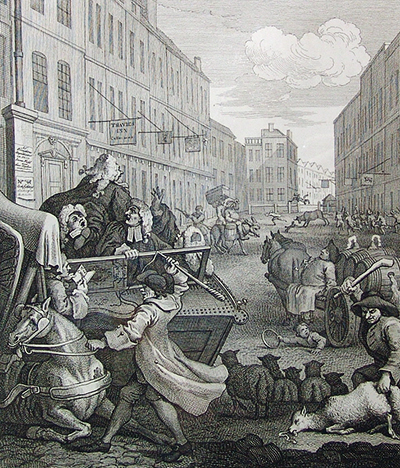In a bid to portray the progression of moral decay in the streets of London, Hogarth created a series of paintings called The Four Stages of Cruelty. This painting is the second in this series and showcases the main character, Tom Nero, beating his horse.
The setting for this painting is at the Thaives Inn Gate, sometimes called the Thieves Inn Gate to depict the evils done here. Hogarth brings out the evil side of a grown-up Tom Nero who has been engaging in recreational cruelty since he was a young boy. Tom's horse is obviously tired due to the heavy load it is carrying and the prolonged mistreatment from its master. As a result, it collapses, breaks its leg and upsets the carriage hoisted on the cart. Tom disregards the horse's distress and beats it furiously. Hogarth also includes other acts of cruelty on the scene - there is drover beating up a lamb near-death and an ass being pushed despite being overloaded all to recount the moral decay of the society.
The Second Stage of Cruelty painting mainly focuses on the Rococo style. It was highly ornamental and combined sculpted moulding, scrolling curves and white and pastel colours to create illusions of drama, motion and surprise. In this painting, Hogarth uses this style to showcase the brutality of the protagonist, Tom Nero, to the worn-out horse. He also sketches other characters in lose, flowing strokes to echo the theme of this collection- the cruelty of London citizen to helpless animals. There's some roughness in the execution of this painting to mimic the brutality of the lead character and impress a message to Hogarth’s target audience. However, the picture still carries a wealth of detail, reminiscent of William’s style.
William Hogarth created this series of paintings in the hope of preventing the cruel treatment of animals. It was a form of moral warning as a result of the inconceivable brutality witnessed on London streets. This painting was also greatly influenced by Hogarth's strong religious beliefs. He was brought up in a Puritan religious family, which relayed a heavy sense of moral duty hence, his quest to create pieces that portray these beliefs. Most of Hogarth's work can be found in the leading museums in the UK. Important prints and other minor works have been displayed permanently at Hogarth's summer villa located in west London and are open for public viewing.




